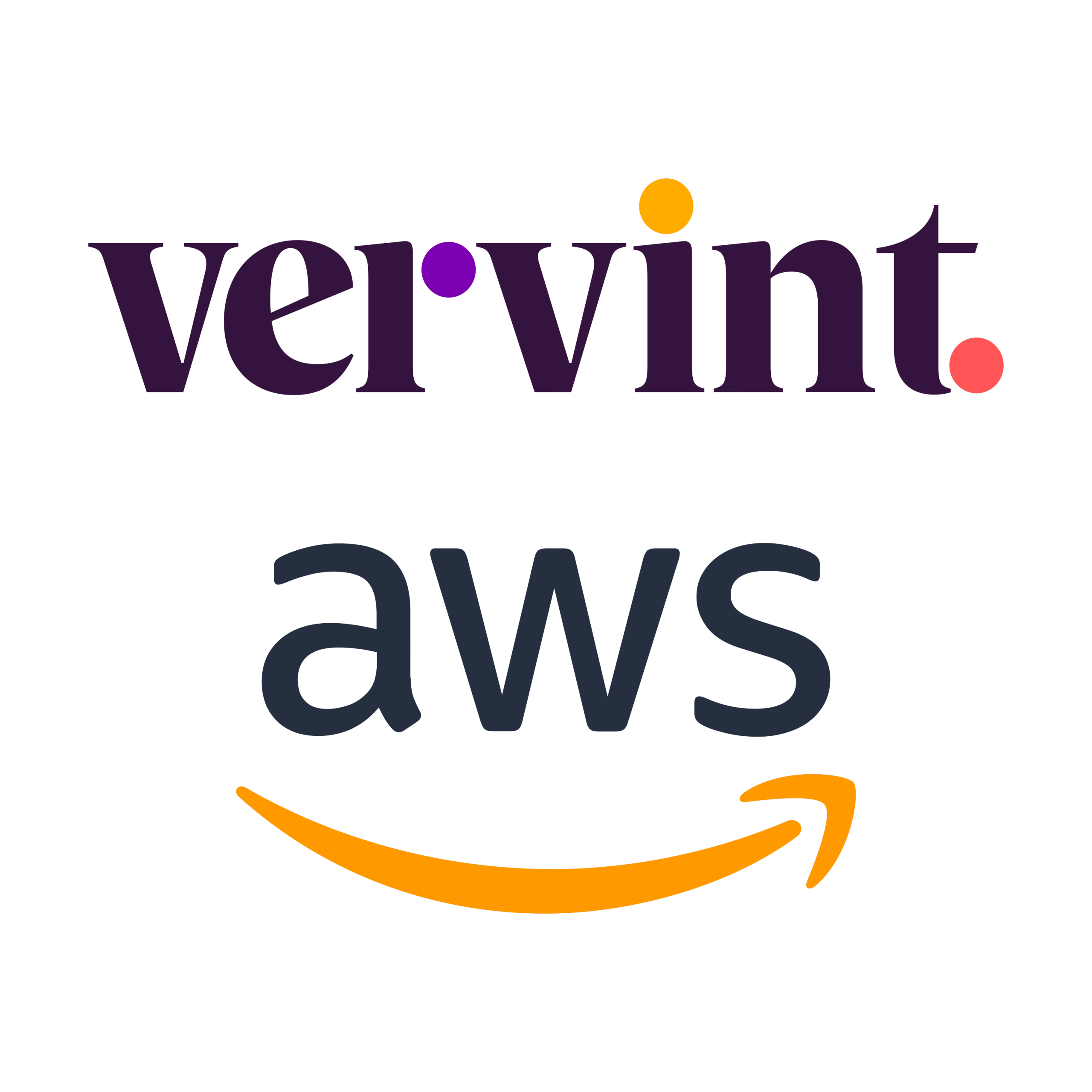In this episode of 10,000 Feet, host Richelle Lentz speaks with Rick Krause from Vervint and Daniel Gross from AWS about the evolution of IoT, the challenges of scaling connected products, and the strategic considerations for migrating to modern platforms like AWS IoT Core. The conversation emphasizes modernization as a viable step for companies not yet ready to migrate fully, highlighting the importance of user experience, edge processing, and managed services.
Enjoy the episode!

Transforming Winnebago Into a Digital-First Innovator
Episode Transcript
0:00
Richelle
Welcome to 10,000 Feet, The Vervint podcast.
0:03
I’m Richelle Lentz, today’s host, and we’re going to dive into a new series around future proofing your connected product and adapting to a rapidly changing market.
0:12
In this episode, I’m joined by two speakers, Rick Krause and Daniel Gross, and we’re going to talk about re platforming and migration insights.
View Full Transcript
0:00
Richelle
Welcome to 10,000 Feet, The Vervint podcast.
0:03
I’m Richelle Lentz, today’s host, and we’re going to dive into a new series around future proofing your connected product and adapting to a rapidly changing market.
0:12
In this episode, I’m joined by two speakers, Rick Krause and Daniel Gross, and we’re going to talk about re platforming and migration insights.
0:23
Welcome, Daniel and Rick, would you mind introducing yourself for me?
0:29
Rick
I’ll go first.
0:30
I’m Rick Krauss.
0:31
I’m a solutions architect here at Vervint.
0:34
I’ve been consulting for about 25 years, the last 15 at Vervint and primarily working on connected products, consumer connected products specifically.
0:47
Thanks, Rick.
0:48
Richelle
Daniel, would you mind introducing yourself?
0:51
Daniel
Sure thing.
0:52
Yeah, thanks for having me on the show today.
0:56
I’m Daniel Gross.
0:57
I am a senior worldwide specialist focused on IoT for AWS and I’ve been at AWS about almost five years total tenure and I’ve been working in IoT about 10 years or so.
1:14
So yeah, thanks again Rachelle and Rick for having me really excited to talk about IoT and, and migrations and modernization.
1:24
Richelle
Great, thank you.
1:25
So before we really dive into kind of the main crux of our topics today, I’d really like to kind of take a step back and talk about, you know, what’s the history of IoT.
1:35
So can we kind of talk about where we’re at and kind of, or where we were and where we’re going or where we’re at?
1:42
Rick, do you mind kind of starting us out kind of what’s your experience historically with IoT?
1:48
Rick
Well, I’ve been kind of working with IoT even before they were calling it IoT.
1:54
It started out as a kind of a niche technology, but now it’s kind of becoming the backbone of modern digital transformation.
2:06
So around 2010 when I started, we were on virtual machine and we basically had to write everything as part of it.
2:21
We had to write our own instrumentation for capturing the data, for going through alerts and everything was a manual process.
2:32
And it wasn’t until about 2016 that I started working in the cloud and that’s when I was introduced to AWS.
2:45
And that was a that was a big game changer that the ability to actually fan out and expand your capacity just kind of gave us a larger footprint that we could reach.
3:03
Daniel
Yeah.
3:03
Just to echo what Rick is saying, I think that early on it was really more just about getting devices connected and, and, you know, getting some of that initial sensor data or telemetry data just because you could and you could sort of see that these devices are active and connected.
3:28
And you could do some things with that.
3:31
But it wasn’t until later that we started getting into, you know, some of the more advanced insights and, and things you could do with that.
3:38
But yeah, early on, I think it was even referred to as machine to machine, M to M, right?
3:45
And, and IoT really hadn’t, hadn’t sort of gotten a name for itself initially.
3:51
But yeah, the, the early days I think were more about pioneering how do we get these devices that, you know, are just dumb devices not connected to any network connected.
4:04
And that was the big driver there.
4:08
Rick
Yes, the, the first projects that we were on was all about how do I onboard the devices and, you know, how do we capture the data and how do we get over the air updates completed, You know, and, and it wasn’t, it wasn’t prepackaged or anything like that at the time.
4:28
It, it was something that we had to pretty much build ourselves.
4:33
And but then as time went on, one of the benefits of working on the AWS platform is things are being built as, as you know, you’re innovating.
4:46
So things like just in time registration, the templated registration came out, the IoT cord, the jobs came out too to help with the over the air updates.
5:02
Things like that really made a difference on subsequent projects so that we could actually get ramped up faster and more efficiently and put the customer in a better place quicker.
5:16
Daniel
Yeah, absolutely.
5:17
The feature sets started to expand at that point and we, you know, we started getting some things like shadows and like, you know, like you’re mentioning some of these, these other types of best practices just in time registration, just in time provisioning, certificate management, all of these, you know, types of things and started seeing the fleets, the fleet sizes grow as well.
5:44
I think a lot of these fleets initially started with, you know, 10s of thousands or hundreds of thousands of, of devices may be at the biggest just to get, you know, an understanding of how this worked.
5:57
And you know, now we see deployments in the millions, 10s of millions, perhaps even hundreds of millions in some cases.
6:05
And, and so the companies that have been successful at that have really run with that and have now seen a lot of advantages in being able to manage devices, get telemetry, do command and control, do insights, offer better overall experiences for, for their customers.
6:32
Richelle
Yeah, I think as we were preparing for this, we talked about what are some of the trends that product owners and those in the IoT and connected product space should be looking for as, as we’re in a more mature market, right.
6:45
We’ve, we’ve moved away from kind of, we referred to it earlier as a, as like a DIY platform to more of a, a modern platform forum with AWS.
6:55
So what are some of those trends that you’re seeing?
6:57
You know, we talked a little bit about security commoditization versus specialization.
7:02
I’m just really curious your perspective on those things.
7:07
Daniel
Sure.
7:08
I think that one thing that we’re seeing is that companies are getting a lot more efficient with how they run their IoT operations and having that add value to how their product is, is being developed.
7:30
And so features that really are important to end users like the behavior of a particular device are being baked in.
7:42
It’s not as much as a just a back end view on, you know, what the devices are doing, but really bringing, bringing the customer experience kind of to the forefront.
7:53
And, you know, looking at less of a commoditization of, you know, bringing IoT devices online, but more of a how do I differentiate my product offering with, with other products maybe in that vertical or, you know, as part of that part of that industry.
8:17
So yeah, we’re seeing it as a way to differentiate for sure.
8:22
And that can be anything from offering subscriptions for video type services to providing specific types of insights based on sensors or other types of interactions.
8:38
At AWS, we see really types of devices across the gambit from, you know, trucks to home, you know, smart home devices to connected factory types of implementations.
8:57
And so there’s value in all of those industries for IoT for sure.
9:07
Richelle
Rick, would you add anything there?
9:09
Rick
Well, I think what we’re seeing is that, you know, edge processing is not just a trend, it’s, it’s kind of a necessity.
9:18
So with the IoT devices, you know, processing data locally reduces a lot of latency and bandwidth costs.
9:28
So there’s a lot more happening that are on the edge and you know, the network with 5G connectivity, you know that, that that’s enabled a multitude of devices.
9:40
Like you’re saying that you know, and also there is a large variety of edge devices with the number of types of devices out there.
9:51
There’s different ways that they’re communicating diverse protocols and things like that.
9:57
Yeah.
9:57
Just think about how many devices you have in your home now that need a Wi-Fi connection compared to maybe, you know, 5-10 years ago, right?
10:08
Rick
I think I’m up to 17 now, so.
10:12
And I think the number might go up a couple in a few days here.
10:16
Richelle
Yeah.
10:16
I mean, think about the days when probably our grandparents, you know, they just made a cup of coffee in their kitchen or a pot of coffee.
10:22
And now my grandma is using a connected coffee maker that has a fresh pot of coffee for her when she wakes up in the morning.
10:29
Rick
And, you know, those are things that are so new to us, but it’s just seeping into every aspect of our life.
10:36
I mean, my parents were, you know, in like an assisted living and at right at the start of, you know, COVID and we, we the only way we could check in on them is through, you know, an Echo show.
10:51
And it’s just like a life saving type thing to, to do that.
10:56
So yeah, it’s really seeping into all aspects of our life.
11:02
Daniel
Also, I think the interoperability between these different devices and these different ecosystems has really been growing where we’re seeing not such siloed applications, but the ability to really manage your, you know, your different devices from different manufacturers kind of together and have some of these kind of fusion type experiences.
11:32
And some ecosystems are expanding.
11:35
Like for example, Amazon Alexa has a number of connectors for different types of devices and we’re seeing some standards like Matter, for example, as a way to connect all kinds of ecosystems from Samsung to Apple to Google to Amazon.
11:55
So it’s, yeah, I think that is maybe another thing that has been happening slowly but definitely impactful.
12:07
So, yeah, absolutely.
12:09
Richelle
So as we think about all of kind of how this market has matured in the trends we’re seeing, you know, one of the big things we talked about is was when is it time to really think about migrating or changing the platform you’re on.
12:22
So I’m curious, what do you see Daniel as, as major triggers for a customer that would maybe want to consider that it’s time to migrate or re platform their IoT devices?
12:34
Daniel
Sure.
12:36
Yeah, we see this at AWS quite a bit as companies grow and as companies use their back end in different ways with different technologies, a lot of things can trigger moving to say AWS as a target.
12:59
But one thing is around scalability for sure is that some of these backends maybe were built around the time that we were talking about before where there was this ramp up to just get devices connected and maybe they weren’t implemented in the most efficient manner.
13:21
And so maybe there’s more modern ways of doing things with a managed platform, for example, versus, you know, some of the home grown types of backends that we’ve seen. Nothing wrong with that, of course, but sometimes that just doesn’t scale for, you know, an operations group where perhaps they’re having to manage many brokers or many gateways or, you know, spin up multiple instances.
13:58
And it becomes kind of a burden just to manage the, the IoT platform to keep the lights on for, for your fleet.
14:07
When it comes to IoT core, for example, AWS handles the undifferentiated heavy lifting, as we call it.
14:15
And, you don’t have to think about provisioning, you don’t have to think about scaling vertically or horizontally.
14:24
That’s all managed for you.
14:26
And so you get to think more about, you know, features or other types of back-end services you want to spend more time on from an operations point of view.
14:39
And so scale can mean a few different things.
14:41
You know, scale can mean how’s my fleet performing, how’s it connecting, all that kind of thing.
14:48
But it can also mean scaling in order to help your organization do higher order activities, right, than just keeping the lights on.
14:58
So yeah, that I think is first and foremost is, is looking at scale.
15:02
Like are, are you scaling your fleet appropriately?
15:07
Rick
And I think, you know, a lot of times what we’re seeing is with customers, that cost becomes a factor if they’re into somebody else’s ecosystem.
15:18
That is like a pay per device type of thing.
15:22
I was talking to a customer the other day there, you know, it’s a flat fee, but their devices aren’t connecting all the time, they’re still paying to be able to support those devices.
15:32
Whereas you know, when you move over to AWS, there’s all sorts of, you know, pay as you go type plans and it, it becomes more cost efficient to be able to do that as well.
15:46
Daniel
That’s a, that’s a very good point.
15:48
We see a lot of overprovisioning, for example, to handle spikes, but that over provisioned infrastructure then does cost money.
15:59
So to reduce your, your OpEx, you can use a managed service like IoT Core.
16:09
You know, we’re very familiar with managed services with Lambda and with Dynamo DB and RDS and things like that, which you know, we refer to as server list.
16:19
But at the end of the day, it’s really about managed services.
16:24
You know, our customers have had a lot of success with that model because you’re not you’re not kind of keeping overprovisioned instances spun up just for those spikes.
16:38
You know, we’ll handle the spikes.
16:40
Richelle
Yeah, absolutely.
16:42
I think one of the other things we talked about when we were prepping is just the increased security vulnerability as we’re seeing in the market.
16:50
What do you guys think about that?
16:51
I know we’ve talked a little bit about some recent, recent news about hacking of different things that, you know, in, in general, you might find kind of funny, but it’s a little scary how sometimes people can get into your devices.
17:04
So just curious what you’re seeing there and maybe how that could be a trigger for somebody to look at.
17:11
Daniel
Yeah, security is super important.
17:14
Yeah.
17:16
But yeah, you mentioned that, you know, some hacks we saw recently.
17:19
We just shared this article that was about crosswalks being hacked and the, the, the audio that comes out of the crosswalks being hacked.
17:30
You can look it up, but it’s, it’s kind of scary that there aren’t better security measures in place for that deployment that somebody could hack into crosswalks and, you know, add their own audio to those.
17:53
It was, you know, somewhat in in jest and, and, and, you know, not necessarily life threatening, but if it was more malicious, that could be very scary, right?
18:05
And, and so really having the right security measures in place is incredibly important and really Job 0 when it comes to IoT.
18:16
And so having, for example, with AWS IoT Core, we have mutual TLS and so you need device certificates and we establish those secure connections as a default and, and help you manage your X5O9 certificates on the back end too with certificate management.
18:41
So yeah, that’s one example.
18:45
And in I’d be, you’d be surprised to see how many IoT fleets are not necessarily secure and they really ought to be to avoid those kinds of vulnerabilities.
18:57
Rick
Yeah.
18:59
Security really is not optional.
19:01
I remember the, the, the 1st that first AWS project was Amway and, and there was a big fear of, you know, did not want to be in the news headlines.
19:12
So they made sure they utilized the most secure method available at the time, which was the just in time registration that, you know, AWS offered.
19:22
And that’s, you know, putting down the certificates on a secure chip by Microchip and, and ended up with a very, very, very good end result.
19:34
Richelle
I was just going to say, we, we’re definitely hearing that from a lot of our clients that that deep concern about, you know, those that are trying to do harm or getting more and more sophisticated every day.
19:46
And so one of the amazing benefits of using a platform like AWS is, is the built in, you know, there’s a lot of really smart people behind the behind the scenes making sure that they have best in class support for anything like that.
19:59
So, you know, it’s definitely top of mind as we look at why people would want to maybe migrate away from something that doesn’t support it that way.
20:08
Rick
And maybe the last reason that I can think of would be the getting at their data.
20:14
A lot of times a customer might be in a position where, you know, it’s difficult to get at the data.
20:20
They’ve got a connected product, but they’re not able to.
20:23
The data isn’t being.
20:25
Structured or laid out where they can get at it in a convenient manner.
20:30
So that would be another
20:31
Richelle
Absolutely.
20:33
We hear that a lot around, you know, the big push for the use of AI really comes down to do you have access to the data to inform that some of those models and things like that will if your platform doesn’t support your ability to get to that data, it’s really difficult to implement some of those, you know, new features we talked about, you know, those compelling user experiences or how you’re driving value in your organization.
20:58
And if your platform is holding you back, it might be a good indicator that it might be time to migrate.
21:05
Daniel
Yeah, again, back to IoT core with the rules engine and access to all of the AWS back end services through the rules engine.
21:15
It’s a great way to integrate your IoT fleet into the cloud.
21:21
If you want access to things like AI models with bedrock or other back-end services where you are trying to improve your overall product feature set or customer experience.
21:37
It’s a great way to, you know, unlock that and spend more time on developing those types of those types of experiences.
21:49
That that may be another red flag, right?
21:52
Where if you’re spending all of your time on the backlog for, you know, managing your platform versus spending time on a backlog for new product features that, you know, that’s a good tip off that OK, you know, we should be spending more time on understanding this example AI, right?
22:18
As everybody is right now.
22:21
Richelle
Yeah, yeah, absolutely.
22:23
So we’ve kind of talked about what the triggers are for migration.
22:27
I’d really love to kind of just briefly talk about what are migration strategies or potentially what are those trade-offs for each of those different strategies?
22:37
Daniel
Sure.
22:37
Yeah, we see a lot of different migration patterns and you think at first you think, OK, migrate, that’s easy, right?
22:45
I just flip a switch and one day I’m on this platform and the next day I’m on this other platform.
22:51
It’s really, it’s really not advisable and usually not doesn’t work out that way that this is usually a phased approach and understanding that is, is really important and especially for IoT because you know, you might come from say a database background or some other type of background or like a CRM background or something like that where you say, oh, a migration is really all on the back end.
23:22
I’m moving one database to another and I can manage all of that in the data center or cloud.
23:30
But when it comes to IoT, migrations are a little more complex.
23:34
There’s this added dimension of the fact that there are devices out in the field that you can’t touch and that you don’t necessarily have direct access to unless you do that through OTA or, you know, some mechanism like that.
23:49
And so some migrations do require a firmware upgrade to change endpoints or certain types of messaging behavior, things like that.
24:01
And so, you know, something to consider when you go into a migration is that this might be a multi-phase approach, both from a firmware point of view as well as the cloud point of view.
24:15
And yeah, there’s different patterns there.
24:17
First of all, if you have a lot of control over the device fleet, you could do a complete rip and replace.
24:26
So if you’re in a factory situation or you have a limited number of devices in the fleet and they’re, you know, being EOL, for example, you could say, OK, we’re going to replace all this equipment with all this new equipment.
24:39
And now that all the new equipment’s going to point to this service where the old equipment pointed to this old service.
24:48
That’s, you know, that’s one way to do it, but often times you don’t.
24:50
Rick
Tear it out and toss it away right.
24:55
Daniel
And then, and then that’s right.
24:58
Well, that’s one way it’s possible, you know, but that’s pretty rare.
25:01
That’s pretty rare.
25:03
Often times it is more of a coordinated effort and requires some type of phased approach where you are either rolling out this update to new firmware and that could be either on existing devices that are deployed or maybe on a new set of SKUs or a new set of products that are new to your fleet.
25:33
And so now those products connect to the new platform where the old products still maybe connect to the old platform and you look at, you know, maybe migrating them eventually.
25:45
There’s different ways to sort of slice and dice that.
25:47
But yeah, Rick, anything to, to sort of add there?
25:53
Rick
I think you’re right.
25:54
Every migration strategy has its own pros and cons.
25:58
The key is to make sure that you have control over it.
26:03
You know, make sure you do those over the air updates, maybe trying with the first segment of your fleet and then verifying the platform.
26:14
Make sure you’ve checked it out before you actually do the full cut over.
26:22
Daniel
OK, so I think one other aspect is testing.
26:26
Testing is, is super important even before you start rolling out.
26:32
Having a limited set of test devices or a friends and family group or a Canary fleet, for example, is really a great way to understand what all of the dynamics you’ll see during a migration for a fleet and to sort of start to start small and ramp up that way.
26:57
Then as you expand to thousands, 10s of thousands, hundreds of thousands, depending on your fleet size, you can do so in kind of a measured fashion as you go.
27:11
So kind of like, you know, when you’re constructing new roads, you still have to have kind of the, the old roads servicing the existing traffic while you’re while you’re constructing the new road, right.
27:27
Rick
Yeah.
27:28
Richelle
I think when we were talking about this before, we, we also mentioned kind of the idea of, I think we referred to it as chaos testing.
27:36
That idea of like you kind of plan for worst case scenario so that hopefully it doesn’t happen.
27:41
But if it does, you know, your team’s not panicking.
27:44
Rick
Yep, services will go down.
27:47
So it’s a very good practice to make sure that you check to make sure that the platform won’t go crazy when you know a certain X service goes down or that you have some sort of mitigation in place so that you can do some region switching so that the consumer doesn’t know an outage that’s localized to a particular region.
28:13
Daniel
Yeah, that’s a good one.
28:16
That’s a good one.
28:17
And I and I think there you could even do some simulation in the cloud for that too.
28:21
So you could say what happens when there’s an outage?
28:26
How do these devices behave?
28:28
And you could even simulate that if you needed to.
28:32
Rick
Yeah, we’ve actually done implementations where you can configure that within the application.
28:38
So just simulate that the service is out via configuration and, you know, then you can check to see how your application performs or you could generate an error to make sure that, you know, the consumer applications are behaving properly when you get different errors as well.
28:59
Daniel
That’s a good point.
28:59
Yeah.
29:00
What, what is the full, full, you know, closed loop on, on behaviors for some of those and, you know, testing even the downstream text messages or, or alerts or things like that.
29:14
Richelle
I think the other thing that I, I really liked that we talk a lot about here, Rick, right, is that idea of the blue/green deployment kind of protecting your production environment from releases.
29:25
So as you’re doing that migration, ensuring that you know you’re planning for how you’re going to maintain this long term and what your changes are going to be and what you can fall back to.
29:34
I know Rick has done an amazing job of educating me on the blue/green deployment over the last little bit here.
29:41
Rick
So right, your best way to mitigate problems is to actually test before the consumer.
29:47
So blue/green is the practice of actually deploying your changes, but have the ability for your test devices to hit that or your testers to hit that area.
30:01
And then once everything passes, you know, there’s a quick switch and you can just go live with one single command.
30:12
Richelle
So we talked about kind of major migrations and things like that, but let’s talk about what if the time isn’t right for you to do that major migration?
30:23
Maybe what are some of your other options as a company looking to maybe take some baby steps towards that?
30:32
Daniel
Sure.
30:33
Yeah.
30:33
I think what goes hand in hand with migration is what we call modernization at AWS.
30:40
And really that’s about looking at platforms to bring them more forward into modernized practices.
30:49
And that is usually about using managed services or looking at more efficient ways to, to handle the data, handle your workloads, handle your operations.
31:05
And it could be something as simple as going from using a MySQL database or something like that to Dynamodb as a managed service.
31:16
And so even just looking at that modernization piece, you know, can have a big impact on cost as well as performance and functionality.
31:30
Richelle
Absolutely.
31:31
Rick
Yep.
31:31
You can take a look at the devices and how their messaging.
31:35
Are all of the messages being sent required?
31:39
Can you tone down the messages?
31:43
And you can look at, yeah, cost I think is another thing to look at.
31:49
Are you processing things or are there unnecessary things going on?
31:54
You know, just try to take a critical look at your system to see if there’s any places that you can mitigate that cost.
32:01
Richelle
Absolutely.
32:02
Daniel
I think, yeah, I like the oh, sorry to interrupt.
32:06
Yeah.
32:06
I also like the idea of, you know, doing more local processing if it’s appropriate, like as you mentioned, you know, just sending sensor data straight, you know, from the edge device to the cloud on a regular cadence isn’t all that smart sometimes when you could be interpreting that for maybe change events or things like that.
32:33
You know, sending 70° on a temperature sensor every minute, you know, adds up on, on the cost.
32:40
And so looking up at looking at cost optimizations, maybe you only send the data when that 70° changes to 71° and, and hook that into say a time stream database, like a time series database and, and you know, look, look at your metrics that way just as an example.
33:01
Richelle
Yeah, I think those are great points.
33:04
I think the other thing we also chatted about a little bit was, you know, looking at your product to see if there’s an ability to make even small tweaks to make it better.
33:13
What are your users kind of experiencing?
33:15
Are there things that they’re getting stuck on?
33:18
Sometimes that’s a change to your platform, maybe it’s a change to your mobile app, maybe it’s a change to your device.
33:24
There’s options, I think, to do some of that modernization that way as well.
33:29
And we talked a little bit about that.
33:30
What do you guys think about those?
33:32
Daniel
Those things For sure.
33:35
I think, you know, something that is even a little bit surprising to me sometimes is hearing from product owners that say their onboarding percentage is maybe not that high.
33:50
You know, if they have a connected product, but only 50% of their customers actually connect the product, What’s going on there?
34:01
Obviously it’s not compelling enough for the customers to connect the product that they purchased.
34:09
What’s the problem?
34:12
Is that a user experience issue?
34:15
Is the feature set for connecting a product not as great that they feel like they get value from that?
34:26
So I think really even looking at that is important.
34:32
One example I give is I will obviously connect like a smart plug or something like that to manage my power or my on and off switch.
34:44
But if I have a connected refrigerator, I’m not really sure what my value is there.
34:50
And I may not onboard that refrigerator unless it provides something of value just as a, you know, just thinking ahead or thinking out loud.
35:01
But the yeah, the point being that what are those features that are gonna compel some consumer to connect the product?
35:10
Richelle
Yeah, absolutely.
35:11
So I think we’re running up to our time here trying to make sure that we get everything in.
35:16
But I wanted to just summarize some of our key takeaways and that is really taking a look at your platform and seeing where you’re at.
35:25
Are there opportunities for you to, is it the right time for you to migrate to maybe a more robust platform like IoT Core with AWS?
35:34
Are there opportunities for you to enhance maybe what you already had, maybe you were an early adopter of the, of the great technology that AWS had as, as their IoT platforms were.
35:45
We’re getting started and maybe there’s opportunity for that modernization and then, you know, where do you go from there and where are those triggers?
35:53
So I think the thing that we had talked about is if you’re having any of those issues, you know, obviously AWS and Vervint are here to help you and we would love to connect with you.
36:06
You can visit our website.
36:08
But anything Daniel or Rick you would add as we wrap up?
36:09
Daniel
Just that Vervint is a great partner with AWS and really happy to, you know, work with you on any, any of these types of efforts.
36:28
And so, yeah, thank you for having me on the show here.
36:32
And this was a really fun discussion, things I like to talk about.
36:36
So again, yeah, you’ve been a great partner and thanks a lot for having me here.
36:45
Rick
Yeah, we’ve made a lot of strides in ways that we can bring the customer up to speed faster on the AWS platform.
36:55
And so, yeah, we would be excited to hear any customers for an opportunity to lend them a hand.
37:04
Richelle
Absolutely.
37:05
Well, thank you both for joining us.
37:07
I want to talk real briefly about our upcoming episodes as we continue to build on this topic.
37:12
We’re looking towards new episodes of leveraging AI and in the future proofing your connected products in our next episode and then building kind of trust in a connected world and proactive security.
37:24
We talked a little bit about how important that is.
37:26
And then lastly, we have one coming up about navigating the smart home explosion and the future proofing of your product within expanding eco system.
37:36
So excited to continue those topics and really appreciate everybody listening to 10,00 foot.
37:41
Rick
Sounds great.
37:43
Daniel
Awesome.
37:44
Thanks, Richelle.
37:44
Richelle
Thank you.
37:45
Rick
Thanks for joining us, Daniel.




